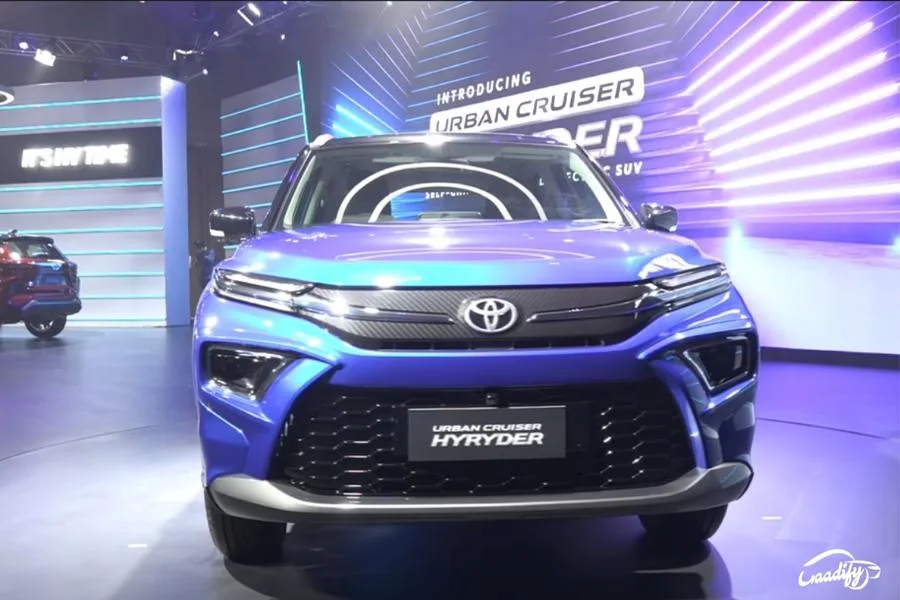- Bookings open for Toyota Urban Cruiser Hyryder.
- Gets two powertrain options: 103PS 1.5-litre k-series petrol with mild-hybrid and 115PS 1.5-litre TNGA petrol with a self-charging strong hybrid system.
- The mild-hybrid unit gets the segment’s first 4WD option.
- Prices are likely to be announced in August.
Toyota Kirloskar Motors has finally unveiled the Creta-rivaling, Urban Cruiser Hyryder for India. Co-developed with Suzuki, the brand is likely to launch this mid-size SUV in August 2022. However, its bookings are now open at all Toyota dealerships for a token amount of Rs 25,000.
Toyota has stated that the Hyryder HEV (Hybrid Electric Vehicle) will be manufactured at its recently renovated Bidadi-based manufacturing facility near Bangalore, Karnataka, and will be exported to other countries as well.
Toyota Urban Cruiser Hyryder – Design
The Toyota Urban Cruiser Hyryder sports a muscular design, featuring a large Crystal Acrylic Grille on the front, edged by twin LED daytime running lamps (DRLs). There is also a distinctive front bumper from other Toyota models with an LED headlamp setup, angular surfaces, and crisp lines.
The SUV rides on machined-cut 17-inch alloys and features a butchy silhouette. Adding to the mighty appearance of the SUV is black plastic cladding along the bottom line.

On the rear end, it gets protruding LED taillights with dual C-shaped light guides, connected by a chrome strip.
Interior and Features
Somewhat similar to the recently launched Maruti Brezza, the all-new Hyryder gets a layered dashboard layout with a 9-inch floating touchscreen infotainment system taking the centre stage. It dons premium-looking leather inserts and silver accents.

In terms of features, the new Hyryder SUV benefits from an all-digital instrument cluster, dual-zone climate control, ventilated front seats, ambient lighting, leather upholstery, wireless smartphone charging, a heads-up display (HUD), premium sound system (Arkamys tuned), connected car tech (55+ features) with remote control functionality, panoramic sunroof, 360-degree camera, 6 airbags, Vehicle Stability Control, Hill Hold & Descent Control, and much more. It would have been better if Toyota had provided it with its advanced Safety Sense suite of advanced driver assistance systems.
Also Read: Toyota Hyryder SUV Variant-wise Features Revealed
Segment’s first AWD System
Under the hood, the Japanese SUV is equipped with Suzuki’s 1.5-litre DualJet DualVVT K15C petrol engine that is capable of developing a maximum power output of 103PS and a peak torque of 135Nm. This familiar powertrain is mated to a 48V mild-hybrid assistance and a 6-speed manual/torque converter automatic transmission. It also gets the segment’s first 4-wheel-drive (4WD) system and multiple driving modes (Snow & Sport). With this, it has become the first monocoque-based SUV in its category to come in a 4WD option.
There’s another powertrain on offer. Yes, the Toyota Hyryder is also available with the brand’s 1.5-litre TNGA engine linked with a self-charging strong hybrid system and e-drive transmission that propels the front wheels of the car. It delivers a combined power output of 115PS and can run in pure EV mode as well.

Color Options
The Hyryder will be offered in seven monotones and four dual-tone hues. These include: –
| Monotone Shades | Dual-Tone Shades |
| – Cave Black – Sportin Red – Speedy Blue – Enticing Silver – Cafe White – Gaming Grey – Midnight Black | – Sportin Red with Black Roof & ORVMs – Speedy Blue with Black Roof & ORVMs – Enticing Silver with Black Roof & ORVMs – Cafe White with Black Roof & ORVMs |
Also Read: Toyota Urban Cruiser Hyryder All Color Options Detailed In Images
Expected Price
Expect prices of the Toyota Hyryder SUV to start from around Rs 11 lakh (ex-showroom), putting it against the likes of the Hyundai Creta, Kia Seltos, MG Astor, Nissan Kicks, Volkswagen Taigun, Skoda Kushaq, and the upcoming Hyryder-equivalent Suzuki Vitara SUV that will be revealed on July 20.








